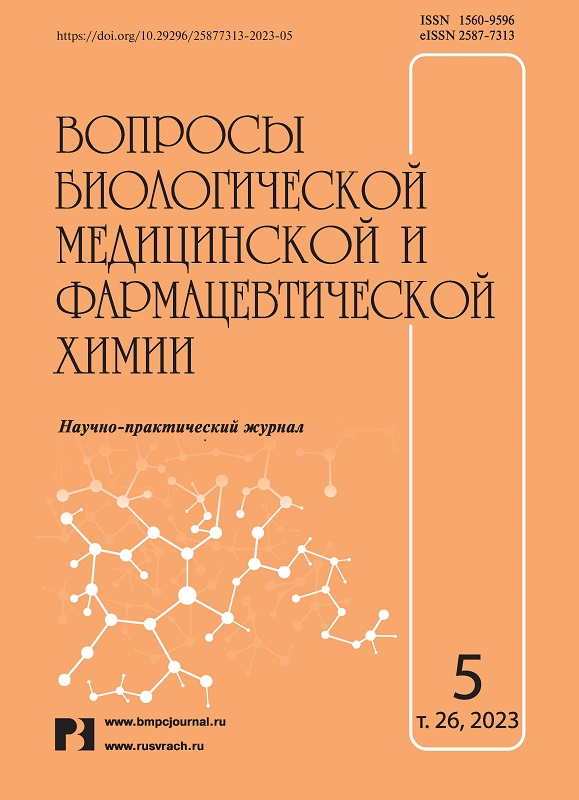Phyto-stimulating effects of paracetamol biodestruction product on urtica dioica
- 作者: Vikhareva E.V.1, Slabinskaya E.V.1, Mishenina I.I.1, Rubzov D.F.1, Rychkova M.I.2
-
隶属关系:
- Perm State Pharmaceutical Academy
- Ural Branch of the Russian Academy of Sciences
- 期: 卷 26, 编号 5 (2023)
- 页面: 32-37
- 栏目: Pharmaceutical chemistry
- URL: https://journals.eco-vector.com/1560-9596/article/view/456467
- DOI: https://doi.org/10.29296/25877313-2023-05-05
- ID: 456467
如何引用文章
详细
Relevance. The search for environmentally friendly methods of processing pharmaceutical waste to obtain new biologically active compounds on their basis, including phytostimulating action, is especially relevant in recent years due to global pharmaceutical pollution of water bodies in many countries. The results of previous studies have shown that the product of bacterial degradation of paracetamol exhibits pronounced phytostimulating properties in relation to medicinal plants of Plantaginaceae, Asteraceae, Linaceae, Lamiaceae and other families.
The purpose of this study is to study the effect of PBP on morphometric parameters, dry biomass and the content of biologically active substances in the leaves of stinging nettle (Urtica dioica L.), a medicinal plant of the family. nettles (Urticaceae).
Material and methods. We used bacterial degradation of paracetamol obtained on the basis of the Laboratory of Alkanotrophic Microorganisms, PFRC, Ural Branch, Russian Academy of Sciences (Perm). Stinging nettle leaves collected from plants treated with bacterial degradation of paracetamol were used to determine the biomass by gravimetric method, morphometric parameters, as well as the content of the total free organic acids, hydroxycinnamic acids and ascorbic acid by titrimetric analysis and spectrophotometry. Water and alcohol extracts from medicinal plant materials were obtained according to the method of the Global Fund XIV ed.
Results. Under the influence of bacterial degradation of paracetamol, the morphometric parameters – the length and width of the nettle leaves increase by 115 % and 66 %, respectively, the total collection of leaf biomass increases by 40 % compared to the control (water). The increase in the content of the total free organic acids under the influence of bacterial degradation of paracetamol is 18.5%, hydroxycinnamic acids – 6.8%, ascorbic acid – 12.5%.
Conclusion. The product of bacterial degradation of paracetamol has a obvious phytostimulating effect on stinging nettle.
全文:
作者简介
E. Vikhareva
Perm State Pharmaceutical Academy
编辑信件的主要联系方式.
Email: ajm@perm.ru
ORCID iD: 0000-0002-7202-0073
Dr.Sc. (Pharm.), Professor, Head of Department of Analytical Chemistry
俄罗斯联邦, PermE. Slabinskaya
Perm State Pharmaceutical Academy
Email: slabliza@yandex.ru
ORCID iD: 0000-0001-8537-8800
Post-graduate Student, Department of Analytical Chemistry
俄罗斯联邦, PermI. Mishenina
Perm State Pharmaceutical Academy
Email: irin-mishenin@yandex.ru
ORCID iD: 0000-0002-6496-7427
Ph.D. (Pharm.), Associate Professor, Department of Pharmaceutical Technology
俄罗斯联邦, PermD. Rubzov
Perm State Pharmaceutical Academy
Email: dennipermcity@gmail.com
ORCID iD: 0000-0002-1109-7675
Student
俄罗斯联邦, PermM. Rychkova
Ural Branch of the Russian Academy of Sciences
Email: richkova@iegm.ru
ORCID iD: 0000-0002-6598-5870
Ph.D. (Biol.), Research Scientist
俄罗斯联邦, Perm参考
- Tjumina E.A., Bazhutin G.A., Kartagena Gomez A.d.P., Ivshina I.B. Nesteroidnye protivovospalitel'nye sredstva kak raznovidnost' jemerdzhentnyh zagrjaznitelej. Mikrobiologija. 2020. 89 (2): 152–168. doi: 10.31857/s0026365620020135.
- Prozherina Ju.A. Farmacevticheskie othody kak novaja jekologicheskaja problema. Remedium. 2017; 11: 14–19. doi: 10.21518/1561-5936-2017-11-14-19.
- Аus der Beek T., Weber F.A., Bergmann A., Hickmann S., Ebert I., Hein A., Küster A. Pharmaceuticals in the environment – Global occurrences and perspectives. Environ-mental Toxicology and Chemistry. 2016; 35: 823−835. doi: 10.1002/etc.3339.
- Wojcieszyńska D., Guzik H., Guzik U. Non-steroidal anti-inflammatory drugs in the era of the Covid-19 pandemic in the context of the human and the environment. Science of the Total Environment. 2022. 834: 155317. doi: 10.1016/j.scitotenv.2022.155317.
- Mohd Hanafiah Z., Wan Mohtar W.H.M., Abd Manan T.S.B., Bachi’ N.A., Abdullah N.A., Abd Hamid H.H., Beddu S., Mohd Kamal N.L., Ahmad A., Wan Rasdi N. The occurrence of non-steroidal anti-inflammatory drugs (NSAIDs) in Malaysian urban domestic wastewater. Chemosphere. 2022; 287(2): 132134. doi: 10.1016/J.CHEMOSPHERE.2021.132134.
- Vihareva E.V., Mishenina I.I., Gapechkina E.D., Seljaninov A.A., Rychkova M.I. Fitostimulirujushhee dejstvie produkta biodestrukcii paracetamola na kalendulu lekarstvennuju. Razrabotka i registracija lekarstvennyh sredstv. 2022; 11(4): 31–37. doi: 10.33380/2305-2066-2022-11-4(1)-31-37.
- Mishenina I.I., Vihareva E.V., Guljaev D.K. Issledovanie fitostimulirujushhego dejstvija produktov biodestrukcii paracetamola na lekarstvennye rastenija semejstva Jas-notkovye. Mediko-farmacevticheskij zhurnal «Pul's». 2020; 22(4): 62–66. doi: 10.26787/nydha-2686-6838-2020-22-4-62-66.
- Korotaev M.Ju. Himicheskaja struktura i fitoregulirujushhee dejstvie produktov bakterial'noj destrukcii paracetamola. Dis. …. k.h.n. Perm', 2016. 125 s.
- Gapechkina E.D. Identifikacija gidroksikorichnyh kislot v izvlechenijah iz produktov biodestrukcii paracetamola. Aktual'nye problemy sovremennoj mediciny i farmacii 2018: sbornik tezisov dokladov LXXII mezhdunarodnoj nauchno–prakticheskoj konferencii studentov i molodyh uchenyh. Minsk. 2018: 1449.
- Reestr Ministerstva sel'skogo hozjajstva RF ot 2 marta 2020 g. «Gosudarstvennyj katalog pesticidov i agrohimikatov, razreshennyh k primeneniju na territorii Rossijskoj Federacii» URL: https://www.garant.ru/products/ipo/prime/doc/73625455/. Data obrashhenija: 02.11.2022.
- Semenov A.A., Karcev V.G. Osnovy himii prirodnyh soedinenij. M.: Nauchnoe partnerstvo. 2009; 1: 408–409.
- Regional'naja specializirovannaja kollekcija alkanotorfnyh mikroorganizmov (iegmcol.ru). Data obrashhenija: 21.10.2022.
- Federal'naja jelektronnaja medicinskaja biblioteka: ofic. sajt. Moskva: Gosudarstvennaja farmakopeja RF, XIV izdanie, 2018, tom I–IV URL: https://femb.ru/record/pharmacopea14. Data obrashhenija: 10.11.2022.
- Trineeva O.V., Slivkin A.I., Voropaeva S.S. Opredelenie organicheskih kislot v list'jah krapivy dvudomnoj. Vestnik VGU. Serija: Himija, biologija, farmacija. 2013; 2: 215–219.
- Bondarchuk S.S. Osnovy prakticheskij biostatistiki. Tomsk: Izd-vo TGPU. 2010. 72 c.
补充文件








